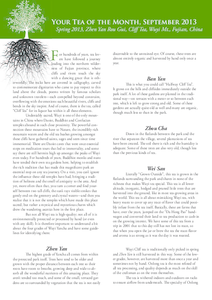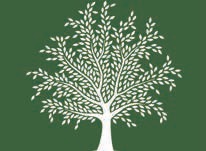
 |
|
For hundreds of years, tea lovers have followed a journey leading into the northern wilderness of Fujian province, where cliffs and rivers touch the sky with a dancing grace that is otherworldly. The rocks here are covered in calligraphy, carved to commemorate dignitaries who came to pay respect to this land above the clouds, poems written by famous scholars and unknown travelers - each compelled beyond constraint, overflowing with the emotions such beautiful rivers, cliffs and bends in the sky inspire. And of course, there is the tea, called "Cliff Tea" for its liquor has within it all these elements.

Undeniably sacred, Wuyi is one of the only mountains in China where Daoist, Buddhist and Confucian temples abound in such close proximity. The powerful connection these mountains have to Nature, the incredibly rich mountain waters and the old tea bushes growing amongst these cliffs have gathered saints, sages and seers since time immemorial. There are Daoist caves that were once essential stops on meditation tours that led to immortality, and some say there are still hermits high up amongst the peaks of Wuyi even today. For hundreds of years, Buddhist monks and nuns have tended their own tea gardens here, helping to establish the rich tradition that has made this magnificent park an essential stop on any tea journey. On a visit, you can't ignore the influence these old temples have had, bringing a tradition of holiness and the smell of antiquity to the area. And yet, more often than that, you turn a corner and find yourself between two tall cliffs, the sun's rays visible strokes that gently end on the greenery and crystal waters - and then you realize that it is not the temples which have made this place sacred, but rather a mystical and mysterious charm which drew the wandering ascetics here in the first place.
But not all Wuyi tea is high-quality; not all of it is environmentally protected or processed by hand (or even with any skill). It is therefore important to understand a bit about the four grades of Wuyi Yancha and have some guidelines for identifying them:
The highest grade of Yancha all comes from within the protected park itself. Trees here tend to be older and grown with the proper distance between each tree so their roots have room to breathe, growing deep and wide to absorb all the wonderful nutrients of this amazing place. They aren't tended too much, and some of the small, terraced gardens are so surrounded by vegetation that the tea is not easily discernable to the untrained eye. Of course, these trees are almost entirely organic and harvested by hand only once a year.
This is what you could call "Halfway Cliff Tea". It grows on the hills and cliffsides immediately outside the park itself. A lot of these gardens are planted in the traditional way - on terraces with a meter or so between each tree, which is left to grow strong and old. Some of these gardens are actually quite old as well and many are organic, though much less so than in the park.
Down in the flatlands between the park and the river that separates the village, several plantations of tea have been created. The soil there is rich and the humidity is adequate. Some of these trees are also very old, though less than the previous kinds of tea.
Literally "Grown Outside", this tea is grown in the flatlands surrounding the park and shares in none of the richness that makes Wuyi tea special. This tea is all lower altitude, inorganic, hedged and pruned little trees that are harvested into the ground, like in most tea-growing areas in the world. This tea is all about mimicking Wuyi tea, with heavy roasts to cover up any trace of flavor that could possibly infuse from the tea itself. Basically, these are farms that have, over the years, jumped on the "Da Hong Pao" bandwagon and converted their land to tea production to cash-in on the growing interest. We have some of this tea from a trip in 2001 that to this day still has not lost its roast, so that when you open the jar or brew the tea the roast-flavor and aroma is as strong as it was the day it was roasted.
Wuyi Cliff tea is traditionally only picked in spring and Zhen Yan is still harvested in this way. Some of the lower grades, however, are harvested more than once a year and sometimes not by hand. Oolong tea is the most refined of all tea processing, and quality depends as much on the skill of the craftsman as on the trees themselves.
The tea is withered indoors and outdoors on racks to ensure airflow from underneath. The specialty of Oolong is that it is shaken around a bamboo tray to bruise the cells in the leaves. You can tell a masterfully shaken Oolong by looking at the edges: the best quality striped Oolong will only be slightly red around the edges, meaning that only this part of the leaf was bruised. Then the tea is pan-fried to kill green enzymes and to arrest oxidation. After that it is rolled to break down the cells and to shape the leaves. Yancha is rolled across ribbed bamboo trays with great skill. The tea is then roasted over charcoal for flavor. Yancha will be roasted more than once since the farmers cannot possibly process all the tea during harvest. They, therefore, give it a short roast to arrest the processing and store all the tea until the harvest is finished, at which time they can slowly roast each of the teas with the attention they deserve. The heavier roasts of Yanchas mean that the tea is better left for some time so that the roast can cool off. Traditionally, spring Yancha wasn't brought to market officially until Chinese New Year the following year (around February).
Our Tea of the Month is a Rou Gui, which is translated as "Cinnabar", "Cassia" or sometimes even "Cinnamon". It is one of the more famous varieties of Yancha. Even a hundred years ago, there were more than 800 kinds of Yancha in the Wuyi area. Nowadays, there are only around sixty left. Rou Gui originally comes from Hua San within the park area, though ours was grown elsewhere in the park - it is definitely a Zhen Yan! This varietal of Yancha is one of the oldest, dating back to the Qing Dynasty. It has larger leaves and a taste of Cassia, from where it gets its name. Our tea is half handmade, which means the leaves are picked by hand but processed with the help of modern machinery. Completely hand made Zhen Yan Cliff Tea would be too expensive to donate.
Yancha is notoriously difficult to prepare. It was made to be brewed gong fu (if you have such a set up). Learning to brew Yancha properly is one of the ways we learn how to make tea gongfu. You can brew it in a side-handle pot or bowl if you have to, but it will shine better when prepared gongfu style. When misbrewed, the tea will become sour. If you get it right, or thereabouts, you'll be rewarded with a dark, golden-amber nectar of the gods with a lasting fragrance and a Heavenly Qi.

The world of Yancha is deep and profound, and you could spend lifetimes brewing this tea without ever plumbing its depths. Such a life would not be wasted. Wuyi tea has been called the "Tea of Immortals" for centuries, drunk by Buddhist and Daoist mendicants alike. The wizened bushes deep in these scenic cliffs have ever been brewed into elixirs of meditation and life, sought out by travelers who traversed leagues of mountains, plains and rivers in search of their legendary golden sutras, whispered from quiet cups directly to the soul...